
To finish-up our discussion of the motions of the Sun and Moon, we want
to briefly discuss the origin of lunar and solar eclipses. It is quite easy
to understand what eclipses are, and why they occur. For example, with
the Moon in orbit around the Earth, it is easy to see that once in a while
it should pass into the Earth's shadow (a lunar eclipse), or that it should
pass between the Earth and Sun, creating a solar eclipse. A solar eclipse
happens during New Moon. Here is the geometry of a solar eclipse:

The Moon just happens to be almost exactly the same angular size as the Sun, so the shadow of the Moon just makes it to Earth, and is very narrow (only a few Km thick). As the Moon slowly moves in front of the Sun, we get a sequence that looks like this:

Due to the loss of energy through tidal interaction with the Earth, the orbital period of the Moon is increasing, as is its distance from the Earth. Eventually, the Moon will be so far away that it will be too small to completely cover the Sun, and "total eclipses" (like the one above, where the Sun is completely hidden by the Moon) will no longer occur, and all eclipses will be "annular":

During a total eclipse of the Sun, we can see the outer atmosphere of the Sun (called the "corona"--we will discuss the structure of the Sun more completely later this semester):

The total phase never lasts more than several minutes. Why do we not see solar eclipses at every New Moon? Because the orbit of the Moon is tilted to that of the Earth (i.e., the "ecliptic"), and thus generally passes above or below the Sun every New Moon:
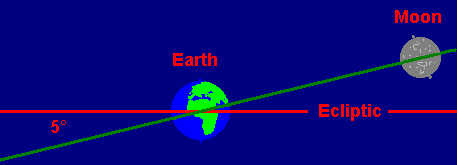
A lunar eclipse is not nearly as spectacular as a solar eclipse, but they are much more viewer-friendly, as they are visible from an entire hemisphere of the Earth, instead of just a narrow band. The reason for this is that the Earth's shadow is much larger than the Moon's, and thus it takes quite a while for the Moon to pass through the shadow:

Here is what one looks like:

During "totality" (mid-eclipse), the Moon takes on a reddish hue:
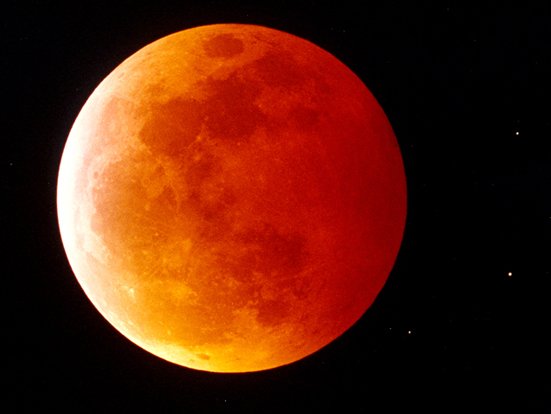
While direct light from the Sun is blocked from reaching the Moon, some sunlight is bent ("refracted") by the Earth's atmosphere and can illuminate the Moon. This refracted light is reddened as the blue light is removed by dust in the atmosphere or scattered out (why the sky is blue!).
The geocentric theory reached its pinnacle with the system devised by Ptolemy. Ptolemy's geocentric theory continued to be the system of choice as the Roman empire succeeded that of the Greeks. With the fall of the Roman empire (circa 450 AD), it was left to the Arabs to keep the Ptolemaic view of the universe alive. In 622 AD, the Prophet Mohammed launched his holy war against the infidels. Within a century, the Islamic Empire extended eastwards across northern India to the borders of China, and westwards across Asia Minor, to north Africa. With the Arabic conquest of Spain and Sicily, the empire made it into western Europe. Alexandria, the center of classical learning, fell to the Arabs in 642. When the period of military expansion ended, Islamic scholars became enthusiastic students of classical philosophy. Many important manuscripts were translated from Greek into Arabic. In the world of medieval Islam, Aristotle and Ptolemy were the supreme authorities in matters of natural science and astronomy. They continued to make observations, and to refine the data that went into the model while streamlining/advancing some of the calculation techniques. But they did not make any modifications to the underlying philosophy.1
"In 999 AD, Gerbert of Aurillac, the most accomplished mathematician, musician, astronomer and classical scholar in Europe, ascended to the papal throne as Sylvester II, known as 'the magician Pope' to his contemporaries. His papacy, at the symbolic date 1000 AD marks the turning point of the European 'dark ages'. Contact was established with Arabic centers of learning in Spain, where Muslim, Christian and Jewish scholars congregated. During the following centuries, Hebrew and Arabic versions of ancient Greek texts were translated into Latin and began to circulate in Europe. The works of Aristotle were translated from around 1200. The translation of Ptolemy's Almagest into Latin in 1175 re-vitalised European astronomy. King Alfonso X of Castile (1122-1184) commissioned new astronomical tables calculated according to Ptolemy's theory with Arabic mathematical refinements. Completed in 1252, the Alphonsine Tables remained the best astronomical tables available in Europe for the next three centuries. The complexities of the Ptolemaic system exasperated King Alfonso however. When the intricacies of epicycles, deferents and equants were explained to him Alfonso 'the Wise' is said to have remarked that if the Almighty had consulted him on the matter, he would have recommended something a little simpler... "1
Eventually, with the re-emergence of European learning in the 13th century, the geocentric view of the universe would be adopted by the Catholic church. It is interesting that in the early European universities, Ptolemy's theory was relegated to the world of mathematics, calendars, and astrology. It was purely a mechanical model of the celestial motion, and not the "true" nature of the universe as described by Aristotle. The latter would be given a more revered place in higher learning, and especially in questions of philosophy and theology.
The Copernican Revolution
In the fifteenth century, a reform of European astronomy began. This was due to the fact that predictions made using the Ptolemaic system were less and less accurate. With the advent of ocean-going vessels, and the expansion of global trade and exploration, navigation using astronomical knowledge had become extremely important. Also, the calendar implemented in 44 BC by Julius Caesar was 10 days off, with the spring equinox now occurring on the 11th of March instead of the 21st (used to fix the date of Easter). Astronomical help was needed! Two astronomers, Peurbach and Regiomontanus (who set up the first European observatory at Nuremburg in 1474) took on the task of locating errors in the works of Ptolemy, as well as errors in published tables and in observations. They had refined some of astronomy, but they had not gotten rid of all of the mounting problems.
Copernicus (1473 to 1543) learned of the works of Peurbach and Regiomontanus while an undergraduate at the University of Cracow (Poland), then spent eight years studying in Italy (five years in Bologna studying liberal arts, and three years at the University of Ferrara where he got a degree in canon law) before returning to a position in the cathedral at Frombork, Poland. Here he spent the majority of his time as a physician, lawyer, and church administrator. In his spare time he dabbled in astronomy. Copernicus was very interested in the Pythagorean mathematics, for he also believed in a harmony of the cosmos. He was, however, not apparently very interested in making new astronomical observations.
By 1514 Copernicus had laid out his heliocentric view of the universe in a manuscript entitled Commentariolus. This short work would put forward most of the elements of the heliocentric system some 39 years before his major manuscript on the theory, De revolutionibus orbium coelestium ("On the Revolutions of the Heavenly Spheres"), was published. While many of the ideas Copernicus was proposing were radical, he still adhered to the Aristotelian view that everything moved in perfect circles, on solid celestial spheres, and moved via the physics espoused by Aristotle. Indeed, he even kept Ptolemy's epicycles in modified form in his new model. But Copernicus knew that his new theory would upset the Church, and he kept it relatively quiet. By moving the Sun to the center of the universe, man was no longer so important, and this could not stand in the view of the Church.
In the intervening years, Copernicus worked very hard at fully developing his view, and this included a number of mathematical devices that greatly advanced the art of calculation. In fact, De revolutionibus closely resembled Almagest in its structure and content. Copernicus feared the repercussions of his work, and was extremely reluctant to publish it. Only after the publication of a summary of Copernicus' system by an enthusiastic supporter named Rheticus in 1540, called Narratio prima, did the aging Copernicus agree to publish his theory. The story goes that Copernicus received a printed copy of his De revolutionibus on his deathbed in 1543.
A diagram from De revolutionibus orbium lays out his system:

Note that this system proposed a radical new idea: the Earth spun on its axis once per day! His theory also gave a simple explanation for the retrograde motions of the planets: the Earth catches up and passes them once each year. He also argued that his system was more elegant than the traditional geocentric system. However, the predictive power of his model was not substantially better than its competition. Besides removing humanity from the central place in God's creation, there were some obvious "problems" with this theory:
1) If the Earth is spinning so fast, how do we remain attached to it--how do birds find their way home again with all of this spinning? [Of course, the counterpoint is what keeps us attached to the spherical Earth in the Geocentric Universe?]
2) Why do the stars not show a parallax? They have to be at immense distances to show no parallax, and thus there is this great empty space in between the last sphere (Saturn) and that containing the stars. [The counter-argument to this is that if all of the stars are at the same distance, no parallax can be measured since all stars would shift the same amount!]
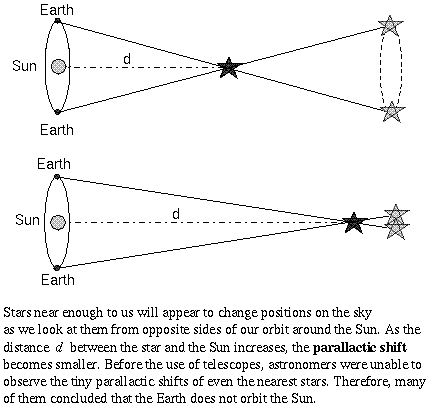
All in all, the Copernican heliocentric model of the universe was very slow to gain acceptance. In fact, during his lifetime and after his death, Copernicus was often the subject of ridicule. But he was never formally charged with any heresies, as the heliocentric model would not really make it on the "radar screen" of the church for another 50 or 60 years (note also that De revolutionibus orbium was dedicated to Pope Paul III!). While the model may not have been accepted, much of the new tabular material and calculation methods were adopted by geocentrically-oriented astronomers for their own calculations on planetary motion.
The next player in the Copernican revolution was Tycho Brahe (1546 to 1601). Tycho was from a privileged background of Danish aristocracy, and thus had a good education and the resources necessary to engage in a variety of pursuits:
"He was brought up by his paternal uncle Jörgen Brahe and became his heir. He attended the universities of Copenhagen and Leipzig, and then traveled through the German region, studying further at the universities of Wittenberg, Rostock, and Basel. During this period his interest in alchemy and astronomy was aroused, and he bought several astronomical instruments. In a duel with another student, in Wittenberg in 1566, Tycho lost part of his nose. For the rest of his life he wore a metal insert over the missing part.
He returned to Denmark in 1570. In 1572 Tycho observed the new star in Cassiopeia and published a brief tract about it the following year. In 1574 he gave a course of lectures on astronomy at the University of Copenhagen. He was now convinced that the improvement of astronomy hinged on accurate observations. After another tour of Germany, where he visited astronomers, Tycho accepted an offer from the King Frederick II to fund an observatory. He was given the little island of Hven in the Sont [=Sound] near Copenhagen, and there he built his observatory, Uraniburg, which became the finest observatory in Europe."2
Tycho went about building the finest astronomical instruments that he could, he ran his own printing press, and he began to train astronomers from all over Europe. He was an excellent observer, and the quality of his observations were higher than any that came before him, and were much better than his contemporaries. Two of his most important observations were of the "new star" of 1572 (now known to be a supernova), and of the comet of 1577. In Aristotle's view, no new stars could occur, the heavens were immutable! He showed that the comet of 1577 had to be further away than the Moon, and that comets were not an atmospheric phenomena as previously believed. These two observations meant that Aristotle's view of the universe was incorrect, the heavenly realm could change. But Tycho could not accept the heliocentric view either, preferring the Aristotelian physics, and the view that man was important and at the center of the universe.
What Tycho did to resolve this was a peculiar halfway step that was a hybrid of the old geocentric view, and Copernicus' new heliocentric view: the "Tychonic" model. In this model, he placed the Earth at the center, and the Moon and the Sun orbited about it. But the other planets all orbited around the Sun!
Johannes Kepler
After a falling-out with the King, Tycho left Denmark and moved to Prague in 1597. There he hired Johannes Kepler (1571-1630) to help him in reducing the data he had collected at Uraniburg. This extensive data base would not get published until many years after Tycho's death (in 1601). Kepler was born in Weil der Stadt in Swabia, in southwest Germany.
"Kepler's teacher in the mathematical subjects was Michael Maestlin (1580-1635). Maestlin was one of the earliest astronomers to subscribe to Copernicus's heliocentric theory, although in his university lectures he taught only the Ptolemaic system. Only in what we might call graduate seminars did he acquaint his students, among whom was Kepler, with the technical details of the Copernican system. Kepler stated later that at this time he became a Copernican for "physical or, if you prefer, metaphysical reasons".
In 1594 Kepler accepted an appointment as professor of mathematics at the Protestant seminary in Graz (in the Austrian province of Styria). He was also appointed district mathematician and calendar maker. Kepler remained in Graz until 1600, when all Protestants were forced to convert to Catholicism or leave the province, as part of Counter Reformation measures. For six years, Kepler taught arithmetic, geometry (when there were interested students), Virgil, and rhetoric. In his spare time he pursued his private studies in astronomy and astrology. In 1597 Kepler married Barbara Müller. In that same year he published his first important work, The Cosmographic Mystery, in which he argued that the distances of the planets from the Sun in the Copernican system were determined by the five regular solids, if one supposed that a planet's orbit was circumscribed about one solid and inscribed in another."3

Kepler's peculiar construction actually produced very good results when predicting the positions of the planets (except for Mercury). Tycho was impressed with Kepler's mathematical skills, and invited him to Prague to be his assistant. When Tycho died, Kepler assumed the position of Imperial Mathematician. In 1604, just like Tycho had, Kepler discovered his own "New Star" (the last known supernova to occur in our Milky Way galaxy). With Tycho's excellent data base, Kepler had all the data he needed to launch a new heliocentric view of the universe. In 1609 he published Astronomia Nova ("New Astronomy") which contained his first two laws of planetary motion:
1. Planets move in elliptical orbits with the sun as one of the foci:
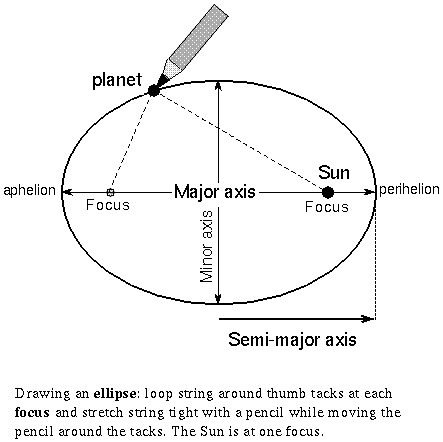
2) A planet sweeps out equal areas in equal times:

It was not until 1618 that Kepler came up with his final law (published in 1619 in Third Law in Harmonices Mundi):
3. The square of the planet's orbital period is proportional to the cube of the orbital size (semi-major axes). In equation form, P2 = K a3, where P is the period, a is the semi-major axis, and K is a constant. In a log-log plot, the relationship looks like this:
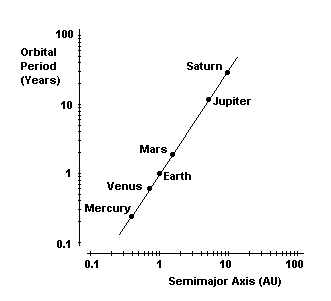
The time taken to complete one orbit grows more than in direct proportion to orbital size. The orbital period is the circumference of the orbit divided by the planet's mean velocity. Since the circumference of an orbit increases in direct proportion to its semi-major axis, the Third Law implies that the velocities of planets in larger orbits are slower than for planets nearer the Sun. A planet with an orbital diameter 5 times the Earth's will require 11 Earth years to complete an orbit.
The timing of the publication (in 1609) of Kepler's original two laws could not have been better, for in 1610, Galileo, published the "Sidereal Messenger", describing his discovery of the four main moons of Jupiter (which we call the Galilean satellites after their discoverer). This discovery showed for the first time that not all celestial objects orbit around the Earth (more on this later!). Kepler quickly published a letter supporting the author and the discovery of these moons. He obtained a telescope that year, and begun his own observations of these moons leading to a write-up describing his observations entitled Narratio de Observatis Quatuor Jovis Satellitibus ("Narration about Four Satellites of Jupiter observed"). These two manuscripts were published in Galileo's home city of Florence, and were a great relief to that beleaguered scientist. By 1611 Kepler had published a preliminary description of how a telescope works in Dioptrice.
Kepler's crowning achievements were his publications entitled Epitome Astronomiae Copernicanae ("Epitome of Copernican Astronomy") in 1621, and his Tabulae Rudolphinae ("Rudolphine Tables" ) in 1627. In Epitome Astronomiae Copernicanae, Kepler fully laid out a new heliocentric model for the universe with the planets on elliptical orbits. This was the first accurate description of how the planets moved. Unfortunately, during the period of 1615-16 there was a witch hunt in Kepler's home country, and his mother was accused of being a witch. Kepler spent several years defending her in court, finally winning her freedom in 1620. On top of this, in 1618 the "Thirty Years War" broke out. Most of Germany and Austria were affected. Kepler suffered some persecution during these years due to the fact that he was a protestant, and during this time the Catholic counter-reformation movement, that was attempting to keep people from leaving the church (as well as attempting to quash the Protestant movement), was raging through Europe. During these years he was attempting to have his new tables on the motions of the planets, the Tabulae Rudolphinae, published in Linz, but a peasant revolt broke out, and the printer's shop where the manuscript was being printed was burned. He left Linz, and finally had the Tabulae Rudolphinae published in Ulm in 1627. The Tabulae Rudolphinae were the most accurate predictions for the motions of the planets that had ever been published, and Kepler had laid the theoretical foundation for the acceptance of the heliocentric theory. This does not mean, however, that Kepler's new theory was quickly adopted as the correct view of the universe--it was not!
Galileo
While Kepler had escaped much of the wrath of the Church, his contemporary, and probably the staunchest supporter of his work, Galileo, would not. Galileo was born in Pisa in 1564, twenty one years after the publication of Copernicus' De revolutionibus orbium, and seven years before Kepler's birth. Galileo's early years would show the personality that would come back to haunt him later in life:
"Galileo received an excellent education at a monastery near Florence, and in 1581, aged 17, showed enough talent for his father to send him to the University of Pisa to study medicine. Though born into the ranks of lower nobility, the Galilei family struggled to make ends meet and were unable to afford the university fees. It was hoped that Galileo would secure one of 40 scholarships available. [he did]
In the second year he showed enough promise to discover that a pendulum of any given length swings at a constant frequency, which led to the invention of the 'pulsilogium', a medical device used for timing the pulse of patients. However, Galileo was already attracting animosity by his reluctance to accept the common philosophy and the scholarship was refused, forcing him to leave the university without attaining his degree. Naturally, biographers have looked upon this as an early resistance to his liberal ideas, though Arthur Koestler in his book, The Sleepwalkers, writes: "It is more likely that the refusal of the scholarship was not due to the unpopularity of Galileo's views, but of his person - that cold, sarcastic presumption, by which he managed to spoil his case throughout his life".
Excluded from university life, Galileo tutored privately and managed to maintain his studies. He developed his interest in mechanics, writing treatises on his inventions which he circulated in manuscript. Another early invention was a hydrostatic balance which attracted the attention of a number of scholars, one of whom, Marchese Guidobaldo del Monte, befriended Galileo and began a chain of recommendations that brought him to the attention of Ferdinand de Medici, the Duke of Tuscany. In a rather ironic twist of fate the Duke was so impressed with Galileo that he appointed him as a lecturer at the university which four years earlier had refused his scholarship. Just three years on, aged 28, he rose to the position of Chair of Mathematics at the esteemed University of Padua, where he remained until 1610.
In 1597, Galileo was to receive his first contact from Johannes Kepler, then aged 26 and employed as Professor of Mathematics at Grantz in Austria. Kepler had completed The Cosmic Mystery, a treatise which expressed arguments in favor of Copernicus' Sun-centered universe. He sent a copy as a gift to the Chair of Mathematics at Padua, anxious for academic feedback. Galileo replied immediately, and wrote in cordial terms:
"I indeed congratulate myself on having an associate in the study of Truth who
is a friend of Truth. For it is a misery that so few exist who pursue the Truth
and do not pervert philosophical reason.... I adopted the teachings of
Copernicus many years ago, and his point of view enables me to explain many
phenomena of nature which certainly remain inexplicable according to the
more current hypotheses. I have written many arguments in support of him and
in refutation of the opposite view - which, however, so far I have not dared to
bring into the public light, frightened by the fate of Copernicus himself, our
teacher who, though he acquired immortal fame with some, is yet to remain to
an infinite number of others (for such is the number of fools) an object of
ridicule and derision. I would certainly dare to publish my reflections at once if
more people like you existed; as they don't. I shall refrain from doing so."Although Kepler replied, imploring him to take a different stance and air his views, Galileo ignored his letter and ended the correspondence. It was 13 years before he would produce the first public indication of his beliefs; throughout the interim he continued to teach, and appeared to endorse the traditional Aristotelian arguments that the Earth did not move."6
The letter to Kepler provides us with excellent insight into the political realities of life in the late 16th century--you had to be careful what you said in a public forum, for you could face serious penalties for going against Church doctrine (see Giordano Bruno). But Galileo would not remain quiet for too much longer, for he was a brilliant experimentalist, and as his fame and reputation grew, so did his confidence that he could challenge the status quo. The problem was that while the Copernicun system might be more elegant in explaining the motions of the planets than the Ptolemaic system, these were mere mechanical details, and were not sufficient reason for the Church and others to overthrow the established system--what was needed were observations that could not be explained by a geocentric view.
We have already noted the two discoveries by Tycho (the supernova and comet) that showed the "superlunary" world was not immutable, contrary to the view of Aristotle. But again, this did not violate the geocentric model for the motions of the planets. Other evidence was needed. This evidence required a new instrument, the telescope.
The invention of the telescope has been credited to Hans Lippershey, a Dutch spectacle maker. But this may or may not be correct (go for here for a bit more). The story goes that in July of 1609 Galileo had heard that a Dutchman had devised an instrument composed of two lenses that made objects appear closer. Not wanting to be scooped, Galileo quickly came up with his own version and:
"In August 1609 he invited the Venetian senate to inspect his own 'spy-glass' which, through a combination of a convex and concave lens, was able to magnify objects nine times greater than normal vision. The senate was greatly impressed, particularly by his suggestion that in matters of defense it would enable them to see the sails of ships two hours before they could be seen by the naked eye. When he presented his spy glass to them as a present they expressed their appreciation by doubling his salary to a thousand scudi a year and guaranteeing his position at Padua for the rest of his life. No doubt he felt some embarrassment when local spectacle makers were soon able to replicate his instruments for just a few scudi, but he committed himself to improving the power of his instruments and began to turn his attention to the heavens.
In March of the following year, 1610, he published Sidereus Nuncius, the 'Messenger of the Stars', which revealed the fruits of his observations. The tract was kept deliberately short in order to make it widely accessible and the style of language was uniquely devoid of philosophy. Combined with explosive contents, it made a remarkable impact worldwide. He wrote about the surface of the Moon, dismissing the common view that it was perfectly smooth, and describing it as full of lofty mountains and deep hollows. He wrote about the fixed stars, and told how he had witnessed "other stars, in myriads, which have never been seen before, and which surpass the old, previously known stars in number more than ten times". Most importantly, he wrote of his discovery of four new planets, the Moons of Jupiter which had never been imagined before.
With this, he justified his first ever 'outing' of his heliocentric beliefs, writing:
"Moreover, we have an excellent and exceedingly clear argument to put at rest
the scruples of those who can tolerate the revolution of the planets about the
Sun in the Copernican system, but are so disturbed by the revolution of the
single moon around the earth while both of them describe an annual orbit
around the Sun, that they consider this theory to be impossible."6
Galileo was assembling the ammunition to mount the final assault on the geocentric model. That objects could orbit Jupiter instead of the Earth, showed that the Earth could in no way be considered the sole center of the universe. A page from Galileo's journal showing some observations of the movements of the moons of Jupiter:
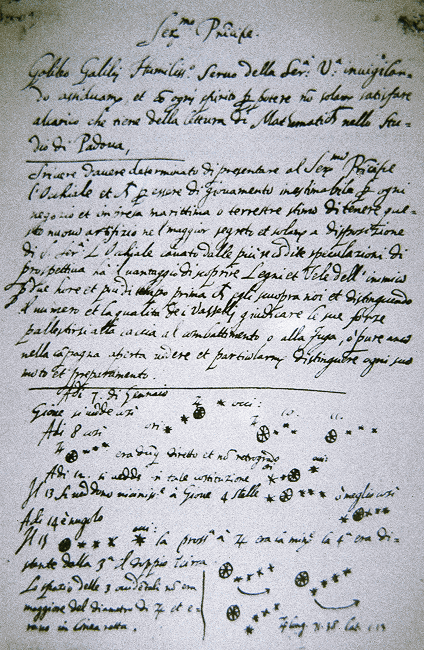
But this, by itself, was not quite sufficient to de-throne the geocentric model, since Tycho had already proposed a hybrid model where Mercury, Venus, Mars, Jupiter and Saturn orbited the Sun, while the Moon and Sun orbited the Earth.
Galileo's observations continued to mount, and one of the most important came in late 1610 when he found that the planet Venus showed phases just like those of the Moon:

[The top part of this figure also shows Galileo's impression of (from
left to right) Saturn, Jupiter and Mars.]
This observation finally ruled out the Ptolemaic system (but, unfortunately, not the Tychonic system!).
He also showed that neither the Sun nor the Moon were perfect, as envisioned in the Aristotelian view of the universe:


Galileo published these findings, and the Church found them offensive--as they violated the Aristotelian view. Galileo eventually was punished, and forced to recant his theories. You can read more about the trials and tribulations of Galileo at my website for the Astronomy 301 course here.
1 From
http://www.skyscript.co.uk/copernicus.html
2 From
http://es.rice.edu/ES/humsoc/Galileo//People/tycho_brahe.html
3 From
http://es.rice.edu/ES/humsoc/Galileo//People/kepler.html
5 From
http://www.skyscript.co.uk/copernicus.html
6 From
http://www.skyscript.co.uk/galileo.html
Some of the figures in today's notes have been taken from Fred Espenak's
excellent website on eclipses. For more beautiful pictures go there.